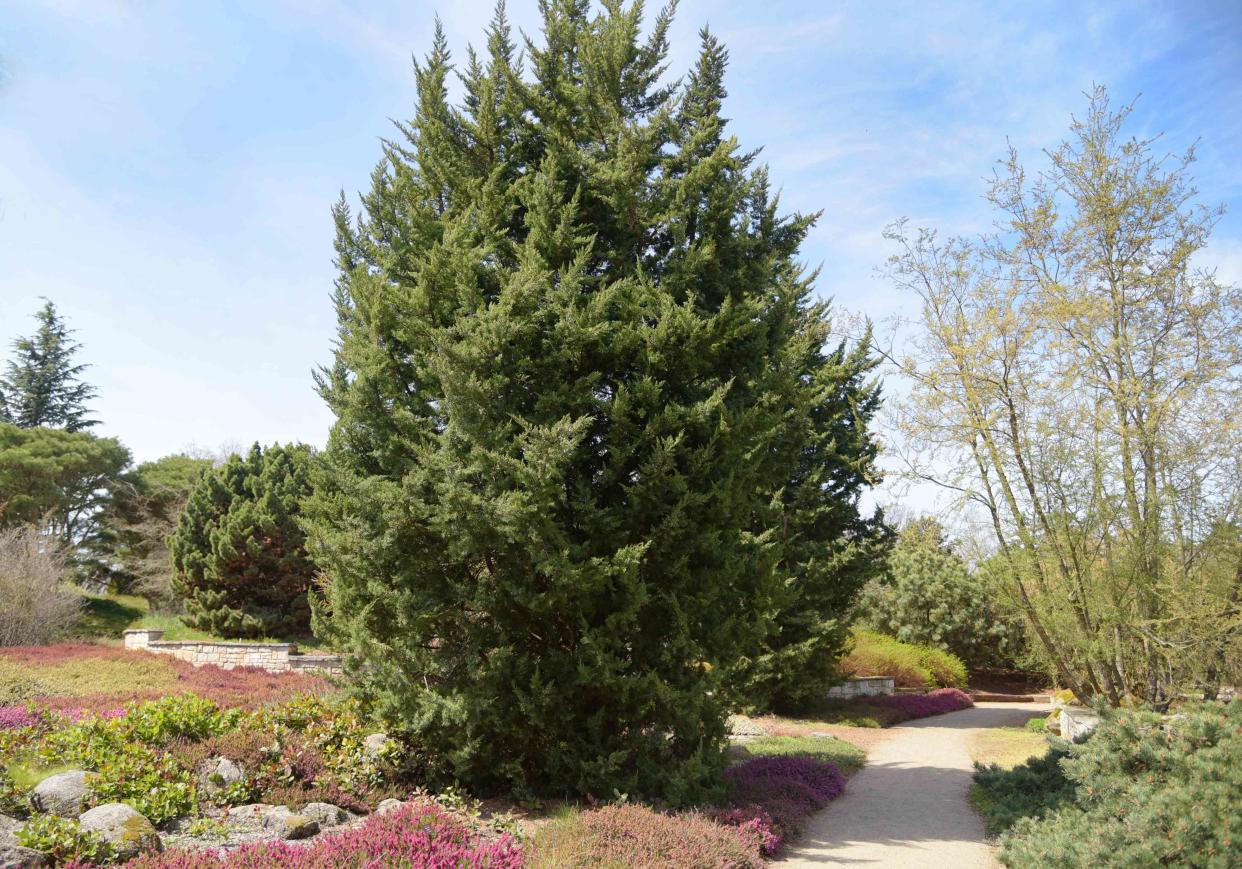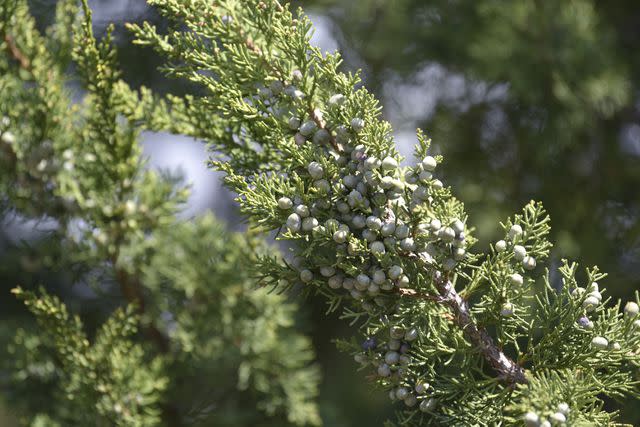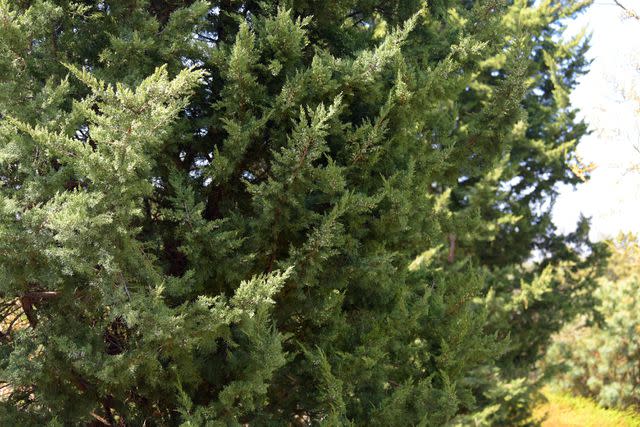How to Grow Chinese Juniper

The Spruce / Evgeniya Vlasova
Chinese juniper is an adaptable, cone-shaped, evergreen plant with prickly, dark green needles that remain attractive year-round. Many varieties have berry-like fruit in the late summer and fall, which tends to attract birds. It is generally best planted in fall and requires moist soil and full sun. Junipers are toxic to humans.
Common Name | Chinese juniper |
Botanical Name | Juniperus chinensis |
Family | Cupressaceae |
Plant Type | Shrub, tree |
Mature Size | 2–40 ft. tall, 15–20 ft. wide |
Sun Exposure | Full |
Soil Type | Moist, well-drained |
Soil pH | Acidic, neutral |
Hardiness Zones | 4–9 (USDA) |
Native Area | Asia |
Toxicity | Toxic to humans |
Chinese Juniper Care
Chinese juniper has many uses in landscaping, including being used as hedges, privacy screens, ground cover, shade trees, and specimen plantings. It's best not to situate it where you'll often be brushing against it, as the foliage is rather coarse and prickly. However, because Chinese juniper is tolerant of salt, it can be used near sidewalks, driveways, and roadways. It is also rarely damaged by animals, such as deer.
Pick a location that will fit the mature size of the plant, as this will minimize the pruning you’ll have to do down the line.
Ensure that the location has excellent drainage and gets ample sunlight.
If you’ve purchased a container plant, dig a hole roughly as deep as its root ball and twice as wide. Place the plant in the hole at the same level it was growing in the container, and firmly pack soil around it. Then, water it thoroughly.

The Spruce / Evgeniya Vlasova

The Spruce / Evgeniya Vlasova
Light
Chinese juniper grows best in full sun. It prefers at least six hours of direct sunlight each day.
Soil
This plant is tolerant of many different soil types, including sandy, rocky, and clay soils. It does best in average garden soil with a neutral to slightly acidic pH. Good soil drainage is critical. Slow-draining soil can cause root rot and other issues for the plant.
Water
Along with adequate drainage, Chinese juniper grows best in moderately moist soil. Water young plants around once or twice a week to maintain soil moisture. You likely won't have to water a mature plant, unless you live in a dry climate or go through stretches with no precipitation. Once Chinese juniper is established, it is fairly tolerant of dry soil and drought.
Temperature and Humidity
Chinese juniper can handle temperature fluctuations within its growing zones, and certain varieties have even more cold tolerance than others. The plant also is tough in both humid and dry conditions, as long as its roots aren’t sitting in soggy soil.
Fertilizer
Fertilizer usually isn’t a necessity for Chinese juniper unless you have nutrient-deficient soil. However, it can help to boost the plant’s growth. Many gardeners choose to feed their juniper annually or every two to three years in the early spring with a complete, slow-release fertilizer.
Types of Chinese Juniper
Chinese juniper has become a popular ornamental landscape shrub or tree and has more than 100 cultivars. Popular ones include:
Blue Point Chinese juniper (Juniperus chinensis 'Blue Point'): This plant grows in a dense pyramid shape at least eight feet tall and features blue-green foliage.
Gold Lace Chinese juniper (Juniperus chinensis 'Gold Lace'): This is a compact shrub with golden foliage, growing only to around three to four feet tall with a little wider spread.
Pfitzer Chinese juniper (Juniperus chinensis 'Pfitzeriana'): This shrub grows around five to 10 feet tall and 15 to 20 feet wide, and it features sage green foliage.
Pruning
Size and shape vary widely among Chinese juniper plants, and this will dictate your specific pruning needs. But in general, pruning is typically best done annually in the late winter or early spring just before growth begins. Prune off any dead, broken, or diseased branches. And then trim back leggy branches to maintain the plant’s shape. Aim to selectively prune branches around the entire plant to increase the amount of light that can reach its center.
If you're looking to form pompom shapes out of a Chinese juniper shrub, some people opt to fashion a circular guide for themselves out of wires. You also can find pre-made guides at garden centers for this purpose. Simply place the guide over your plant, and remove the foliage outside of it.
Moreover, you can eyeball the cuts if you're comfortable doing so. Chinese juniper tends to be very forgiving of slight pruning mistakes. So if you prune a bit too much, just give the plant a little growth time to correct your mistake. For pompoms, prune around three to four times a year to promote denser growth.
Propagating Chinese Juniper
Propagating Chinese juniper from cuttings is possible but keep in mind that many upright varieties are grafted trees so using a branch from it for propagation will not result an identical plant. For non-grafted plants, follow these steps:
In late summer, take 4- to 6-inch cuttings from the tips of branches. Ideally, the snipped ends of the cuttings should have a tinge of brown wood.
Strip off the needles from the bottom half of the cutting, then dip it in rooting hormone.
Plant the cutting in a pot filled with porous potting medium, such as sand or perlite mixed with a commercial potting mix.
Place the potted cuttings in a sheltered, relatively warm location and keep them moist until they develop roots; this can require anywhere from six to 12 weeks. In cold winter regions, move the potted cutting into a sheltered location (a cold frame is ideal) during the winter months.
Allow the rooted cutting to continue growing in containers for a full year. By the following fall, the slow-growing plants should be ready for planting in the landscape.
How to Grow Chinese Juniper from Seed
As most Chinese junipers grown as landscape plants are cultivars, their seeds won't produce a plant that is true to the parent. Therefore propagation from seed is not recommended.
Potting and Repotting Chinese Juniper
Small upright varieties of Chinese juniper can be grown in a container. Terra-cotta is ideal because they don't topple over easily and they let excess moisture evaporate. For container size, it should be at least 8 inches larger in diameter than the current root system to give it room to grow. Flll it with a blend of commercial potting mix and sand or perlite
When the roots fill the container or grow out of the drainage holes, after about two to three years, repot it to a larger container one size up and filled with fresh potting soil.
Overwintering
When planted in garden soil, Chinese juniper is hardy to USDA zone 4 and does not need any winterization.
Container plants are a different story, as their roots aren't sufficiently insulated against winter freeze. Wrap the container in burlap and bubble wrap to protect the root, or place the entire container in an insulating silo for the winter.
Common Pests and Plant Diseases
Chinese junipers are prone to tip and needle blights and canker on the bark or main stems. The plant is one of the hosts of cedar-apple rust. In wet, poorly drained soils, it can get root rot.
Possible pests include include aphids, bagworms, webworms, and scale insects.
Common Problems with Chinese Juniper
Chinese junipers are fairly low-maintenance plants that are resistant to nuisances such as deer and tolerant of environmental challenges such as pollution and erosion. That being said. there are a few problems you could encounter.
Needle Browning
Needle browning starts with yellow tips that become dry and drop off, usually beginning at the needles closest to the trunk. If it spreads to the entire plant, it can be fatal. To prevent this, avoid drought while also being careful not to overwater.
Dieback of Shoot Tips
Juniper trees often experience dieback of shoot tips or the whole shoot. Needles will drop and dark cankers may appear at the junction of live and dead wood. This problem usually occurs during warm, wet weather conditions and is typically caused by a fungal disease.
To avoid stressing the plants, it is important to not place them in shady locations that are poorly draining. Promote good air circulation so that the tree can dry out when needed. If any browning shoots occur, they should be pruned as soon as possible. Fungicides can be applied but should be a last resort.
Frequently Asked Questions
Is Chinese juniper invasive?
Even though Chinese juniper is not native to North America, the plant is not considered invasive.
Can Chinese juniper be grown as a bonsai?
Yes, it's one of the junipers suitable to be trained as a bonsai. Some shrubs are even pruned into pompoms to add visual interest to a garden.
Are Chinese juniper berries edible?
These are not the juniper berries for culinary use. Leave the berries of Chinese juniper as food for wildlife, they are bitter and not palatable.
Read the original article on The Spruce.

